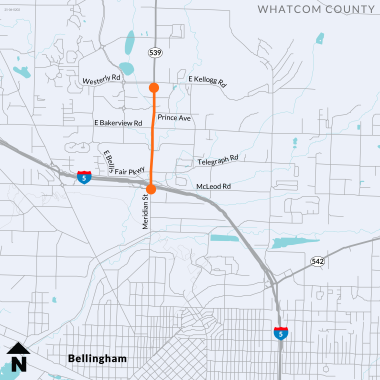Project overview
This project will resurface the northbound and southbound lanes of State Route 539 from Interstate 5 to Kellogg Road in Bellingham to extend the pavement service life. Crews working for WSDOT will grind and inlay new Hot Mix Asphalt (HMA), perform pavement repair, traffic loop replacement, striping and traffic control.
Pedestrian curb ramps will be evaluated and updated as necessary to meet the Americans with Disabilities Act and current accessibility standards. Additionally, this project is subject to WSDOT’s Complete Streets requirements. We will be working to incorporate as much active transportation facilities as feasible within the project delivery timelines.
What to expect
This project is currently in the early stages of the Complete Streets pre-design phase, which will continue through fall 2025. The pre-design process will include meetings, events and other engagement opportunities with interested parties and the public. The design phase is expected to last through summer 2026, with construction anticipated in summer 2027.
This project will pave and make ADA improvements in both directions of State Route 539, from Interstate 5 to Kellogg Road in Bellingham.
State Route 539 is a 15.18-mile state highway, connecting Interstate 5 to the Canadian border at the Lynden-Aldergrove crossing. The first 2.40 miles are in Bellingham and a segment passes through Lynden (MP 10.32-11.54). The rest of the highway connects through Whatcom County.
Each day, 35 thousand to 52 thousand vehicles use this highway. Annual Average Daily Traffic counts on SR 539 are:
- 40,000 daily at the Interstate 5 interchange vicinity
- 52,000 daily from the I-5 interchange through intersection at Telegraph Road
- 36,000 daily north of Telegraph Road through Kellogg Rd intersection
It is a significant freight corridor with between 4 million and 10 million tons of goods moved per year.
Repaving SR 539 is important to the WSDOT pavement and preservation program and to maintain a state of good repair. Regular, scheduled pavement maintenance is a better long-term investment than needing to make unscheduled emergency repairs. This portion of SR 539 was last paved in 2005 and is due to be resurfaced.
There is one interchange within the project area with a total of five ramps that provide access on and off I-5.
Both I-5 and SR 539 have been identified by the local community as barriers to effective connections across all modes of transportation.
Complete Streets
In 2022, Washington passed the Complete Streets legislation (Senate Bill 5974) to support safer, more inclusive roadways for everyone. Following this guidance, our project will begin with a Complete Streets Pre-design phase. This early planning step will explore ideas for how the corridor can better serve all users—people walking, biking, taking the bus, driving, or delivering goods. We’ll look at ways to improve crossings and design street layouts that include space for cars, buses, trucks, bikes, and pedestrians—all in one coordinated plan.
Agency, tribal and community engagement
Agency, Tribal and Community engagement will be conducted throughout the project. Specific engagement opportunities will be updated as the project advances. The pre-design phase of the project will seek to understand the needs of tribes, overburdened communities, freight operators, transit riders, pedestrians, bicyclists, residents, businesses, and other interested parties in the area. Engagement will inform design considerations to create a corridor that serves all modes.
Community Questionnaire
July 10 - Aug. 14, 2025
Summary (PDF 220KB)

